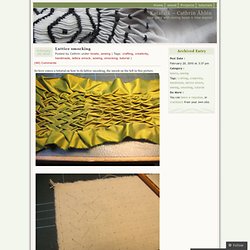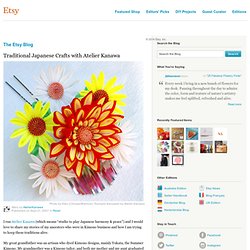

10 Beautiful Fabric Flower Tutorials. It is spring!

If the flowers are not blooming yet here is a round-up of awesome tutorials to help you make your own flowers! Here you will find 10 beautiful fabric flowers, but don’t miss these five fabric flower tutorials! Step By Step Guide To Felt Flowers 5 Ways. This guest post was written by Cathy of Catshy Crafts.

I’ve always loved felt. It’s easy to work with, relatively inexpensive and comes in a rainbow of colors. One of my favorite things to make out of felt are dimensional flowers. You can glue them to a hair clip or headband for a quick and easy hair accessory, use as a gift topper or just give them as is. I know my daughters can get pretty excited over a few hand-made blossoms. Materials: 1. 9 x 12 sheets of felt in colors you love 2. Here’s how to make it: 1. Step 1: Fold over over a sheet of felt lengthwise about 2.75 inches. Step 2: With the strip still folded in half lengthwise, cut your felt on the non-folded side in even intervals about 1/2 away to 3/4 down. Step 3: Starting at one end, snugly roll your fringed strip until you get to the other end.
Step 4: Now it’s time to sew. Step 5 (optional): Add faux pearl or vintage button to the center for a little glam. 2. To get the loopy flowers, the same steps apply as above. Tudor Rose Tutorial Remix. Quite a while ago I typed up a little post about some Tudor Rose purses I had made.

The original pattern came from a now defunct website called SavvySeams.com. I did not draft this pattern, but I love it so very much. It should not be lost to the world. What remains of SavvySeams.com can be seen through a web archive service. If you look HERE you'll see what remains of the original pattern and may notice that many of the photos are gone. You can see a little gallery of photos of the flower I made for this tutorial HERE. Here's my remix of the flower portion of the tutorial: Getting Started: Choosing fabric.The fabric should be medium to heavy weight. Other supplies. You'll need the basic machine sewing supplies: coordinating thread, scissors, iron, etc.You'll also need to do some hand sewing so be sure you have a needle and thread on hand.Batting or wadding.
First, I cut out the fabric: Second, I make the leaves: Third, I make the petals: Fourth, attach the leaves to the petals: Lattice (Canadian) Smocking. So here comes a tutorial on how to do lattice smocking, the smock on the left in this picture.

Just as in honeycomb smocking one have a net of dots on the fabric, this time we are marking them out on the backside of the fabric. To make it simple we also mark out how we are going to gather the dots this time. In this kind of smocking we are working from the back, so the result will not be visible unless you turn your work over. It is also hard to see how it looks until you have made a few rows. Like this. Here is a diagram that show you how to do it, but I’ll explain with pictures to. Stick the needle up the second dot on the second row. Pick up some fabric, just like three threads or so, and go to the first dot on the fist row and pick up some fabric there to.
Gather, sew some stitches and secure the thread. Go to the dot directly under and secure the thread, all the threads that you do not gather should lie loose on the back. Traditional Japanese Crafts: Silk Folded Flowers. I run Atelier Kanawa (which means “studio to play Japanese harmony & peace”) and I would love to share my stories of my ancestors who were in Kimono business and how I am trying to keep these traditions alive.

My great grandfather was an artisan who dyed Kimono designs, mainly Yukata, the Summer Kimono. My grandmother was a Kimono tailor, and both my mother and my aunt graduated from Kimono academy. My aunt has been teaching Kimono classes in Japan. Since January in 2005, I have been studying Kimono and dressing with them myself. And since March 2006, I have been learning to dress other people.
I also study how to dye Kimono designs by Bingata Katazome, which is the traditional Japanese method of dyeing fabric in Okinawa (southern part of Japan), using a resist paste applied through stencil. I am also pursuing classical Japanese dance by Hanayagi-style, which includes Geisha dance, Noh, and Kabuki. Today, there are ONLY 15 acknowledged Tsumami Kanzashi artisans in the whole world.
Part 1.